FIAT FULLBACK 2016 1.G Owners Manual
Manufacturer: FIAT, Model Year: 2016, Model line: FULLBACK, Model: FIAT FULLBACK 2016 1.GPages: 312, PDF Size: 13.67 MB
Page 121 of 312
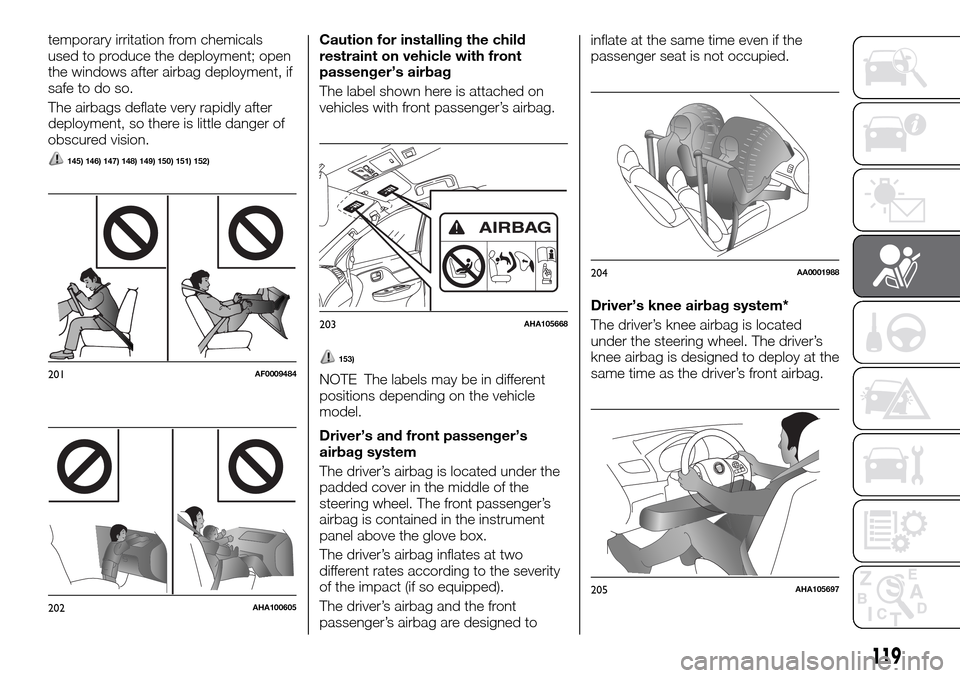
temporary irritation from chemicals
used to produce the deployment; open
the windows after airbag deployment, if
safe to do so.
The airbags deflate very rapidly after
deployment, so there is little danger of
obscured vision.
145) 146) 147) 148) 149) 150) 151) 152)
Caution for installing the child
restraint on vehicle with front
passenger’s airbag
The label shown here is attached on
vehicles with front passenger’s airbag.
153)
NOTE The labels may be in different
positions depending on the vehicle
model.
Driver’s and front passenger’s
airbag system
The driver’s airbag is located under the
padded cover in the middle of the
steering wheel. The front passenger’s
airbag is contained in the instrument
panel above the glove box.
The driver’s airbag inflates at two
different rates according to the severity
of the impact (if so equipped).
The driver’s airbag and the front
passenger’s airbag are designed toinflate at the same time even if the
passenger seat is not occupied.
Driver’s knee airbag system*
The driver’s knee airbag is located
under the steering wheel. The driver’s
knee airbag is designed to deploy at the
same time as the driver’s front airbag.201AF0009484
202AHA100605
203AHA105668
204AA0001988
205AHA105697
119
Page 122 of 312
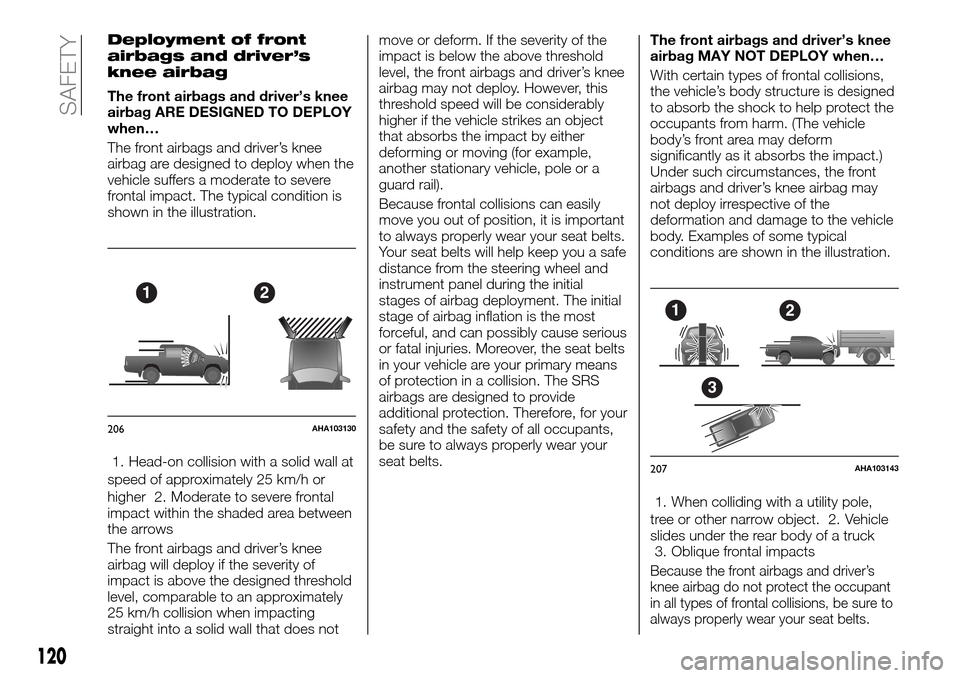
Deployment of front
airbags and driver’s
knee airbag
The front airbags and driver’s knee
airbag ARE DESIGNED TO DEPLOY
when…
The front airbags and driver’s knee
airbag are designed to deploy when the
vehicle suffers a moderate to severe
frontal impact. The typical condition is
shown in the illustration.
1. Head-on collision with a solid wall at
speed of approximately 25 km/h or
higher 2. Moderate to severe frontal
impact within the shaded area between
the arrows
The front airbags and driver’s knee
airbag will deploy if the severity of
impact is above the designed threshold
level, comparable to an approximately
25 km/h collision when impacting
straight into a solid wall that does notmove or deform. If the severity of the
impact is below the above threshold
level, the front airbags and driver’s knee
airbag may not deploy. However, this
threshold speed will be considerably
higher if the vehicle strikes an object
that absorbs the impact by either
deforming or moving (for example,
another stationary vehicle, pole or a
guard rail).
Because frontal collisions can easily
move you out of position, it is important
to always properly wear your seat belts.
Your seat belts will help keep you a safe
distance from the steering wheel and
instrument panel during the initial
stages of airbag deployment. The initial
stage of airbag inflation is the most
forceful, and can possibly cause serious
or fatal injuries. Moreover, the seat belts
in your vehicle are your primary means
of protection in a collision. The SRS
airbags are designed to provide
additional protection. Therefore, for your
safety and the safety of all occupants,
be sure to always properly wear your
seat belts.The front airbags and driver’s knee
airbag MAY NOT DEPLOY when…
With certain types of frontal collisions,
the vehicle’s body structure is designed
to absorb the shock to help protect the
occupants from harm. (The vehicle
body’s front area may deform
significantly as it absorbs the impact.)
Under such circumstances, the front
airbags and driver’s knee airbag may
not deploy irrespective of the
deformation and damage to the vehicle
body. Examples of some typical
conditions are shown in the illustration.
1. When colliding with a utility pole,
tree or other narrow object. 2. Vehicle
slides under the rear body of a truck
3. Oblique frontal impacts
Because the front airbags and driver’s
knee airbag do not protect the occupant
in all types of frontal collisions, be sure to
always properly wear your seat belts.
12
206AHA103130
2
3
1
207AHA103143
120
SAFETY
Page 123 of 312
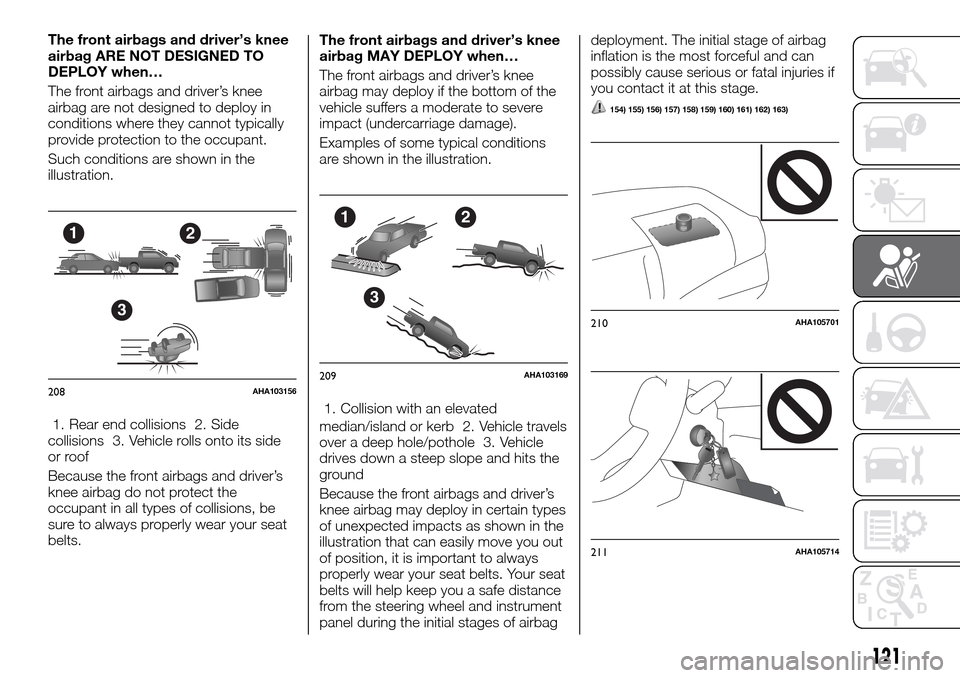
The front airbags and driver’s knee
airbag ARE NOT DESIGNED TO
DEPLOY when…
The front airbags and driver’s knee
airbag are not designed to deploy in
conditions where they cannot typically
provide protection to the occupant.
Such conditions are shown in the
illustration.
1. Rear end collisions 2. Side
collisions 3. Vehicle rolls onto its side
or roof
Because the front airbags and driver’s
knee airbag do not protect the
occupant in all types of collisions, be
sure to always properly wear your seat
belts.The front airbags and driver’s knee
airbag MAY DEPLOY when…
The front airbags and driver’s knee
airbag may deploy if the bottom of the
vehicle suffers a moderate to severe
impact (undercarriage damage).
Examples of some typical conditions
are shown in the illustration.
1. Collision with an elevated
median/island or kerb 2. Vehicle travels
over a deep hole/pothole 3. Vehicle
drives down a steep slope and hits the
ground
Because the front airbags and driver’s
knee airbag may deploy in certain types
of unexpected impacts as shown in the
illustration that can easily move you out
of position, it is important to always
properly wear your seat belts. Your seat
belts will help keep you a safe distance
from the steering wheel and instrument
panel during the initial stages of airbagdeployment. The initial stage of airbag
inflation is the most forceful and can
possibly cause serious or fatal injuries if
you contact it at this stage.
154) 155) 156) 157) 158) 159) 160) 161) 162) 163)
2
3
1
208AHA103156
2
3
1
209AHA103169
210AHA105701
211AHA105714
121
Page 124 of 312
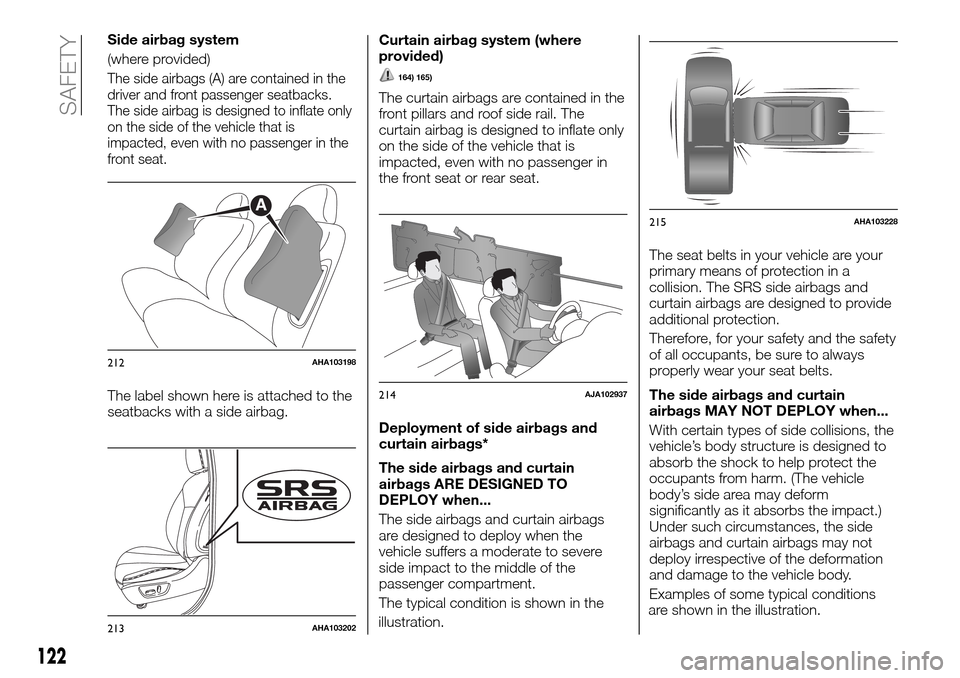
Side airbag system
(where provided)
The side airbags (A) are contained in the
driver and front passenger seatbacks.
The side airbag is designed to inflate only
on the side of the vehicle that is
impacted, even with no passenger in the
front seat.
The label shown here is attached to the
seatbacks with a side airbag.Curtain airbag system (where
provided)
164) 165)
The curtain airbags are contained in the
front pillars and roof side rail. The
curtain airbag is designed to inflate only
on the side of the vehicle that is
impacted, even with no passenger in
the front seat or rear seat.
Deployment of side airbags and
curtain airbags*
The side airbags and curtain
airbags ARE DESIGNED TO
DEPLOY when...
The side airbags and curtain airbags
are designed to deploy when the
vehicle suffers a moderate to severe
side impact to the middle of the
passenger compartment.
The typical condition is shown in the
illustration.The seat belts in your vehicle are your
primary means of protection in a
collision. The SRS side airbags and
curtain airbags are designed to provide
additional protection.
Therefore, for your safety and the safety
of all occupants, be sure to always
properly wear your seat belts.
The side airbags and curtain
airbags MAY NOT DEPLOY when...
With certain types of side collisions, the
vehicle’s body structure is designed to
absorb the shock to help protect the
occupants from harm. (The vehicle
body’s side area may deform
significantly as it absorbs the impact.)
Under such circumstances, the side
airbags and curtain airbags may not
deploy irrespective of the deformation
and damage to the vehicle body.
Examples of some typical conditions
A
212AHA103198
213AHA103202
214AJA102937
215AHA103228
122
SAFETY
are shown in the illustration.
Page 125 of 312
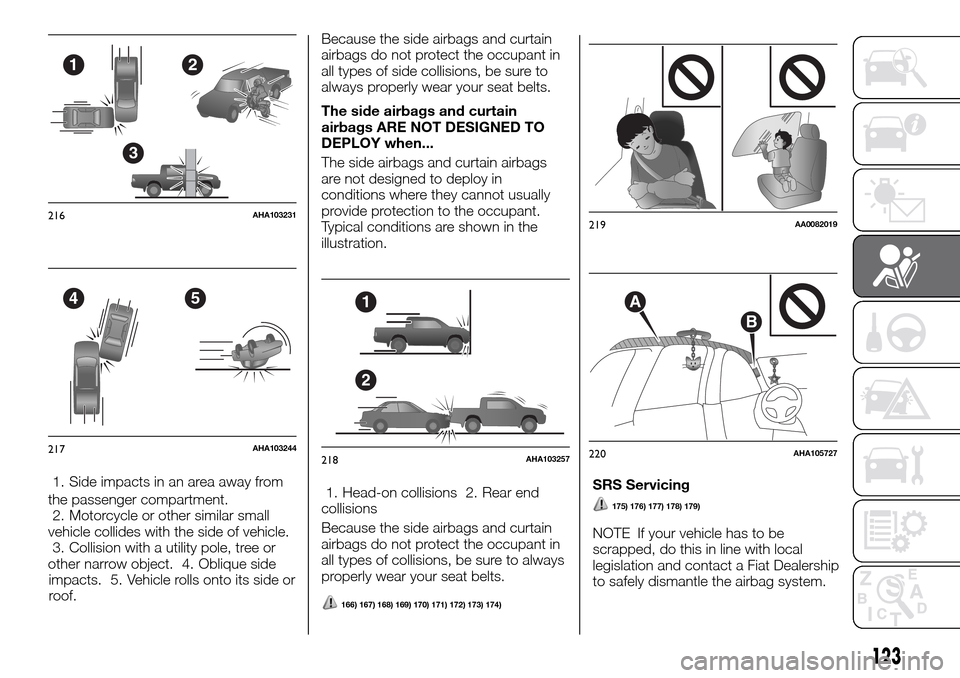
1. Side impacts in an area away from
the passenger compartment.
2. Motorcycle or other similar small
vehicle collides with the side of vehicle.
3. Collision with a utility pole, tree or
other narrow object. 4. Oblique side
impacts. 5. Vehicle rolls onto its side or
roof.Because the side airbags and curtain
airbags do not protect the occupant in
all types of side collisions, be sure to
always properly wear your seat belts.
The side airbags and curtain
airbags ARE NOT DESIGNED TO
DEPLOY when...
The side airbags and curtain airbags
are not designed to deploy in
conditions where they cannot usually
provide protection to the occupant.
Typical conditions are shown in the
illustration.
1. Head-on collisions 2. Rear end
collisions
Because the side airbags and curtain
airbags do not protect the occupant in
all types of collisions, be sure to always
properly wear your seat belts.
166) 167) 168) 169) 170) 171) 172) 173) 174)
3
12
216AHA103231
45
217AHA103244
2
1
218AHA103257
219AA0082019
A
B
220AHA105727
123
SRS Servicing
175) 176) 177) 178) 179)
NOTE If your vehicle has to be
scrapped, do this in line with local
legislation and contact a Fiat Dealership
to safely dismantle the airbag system.
Page 126 of 312
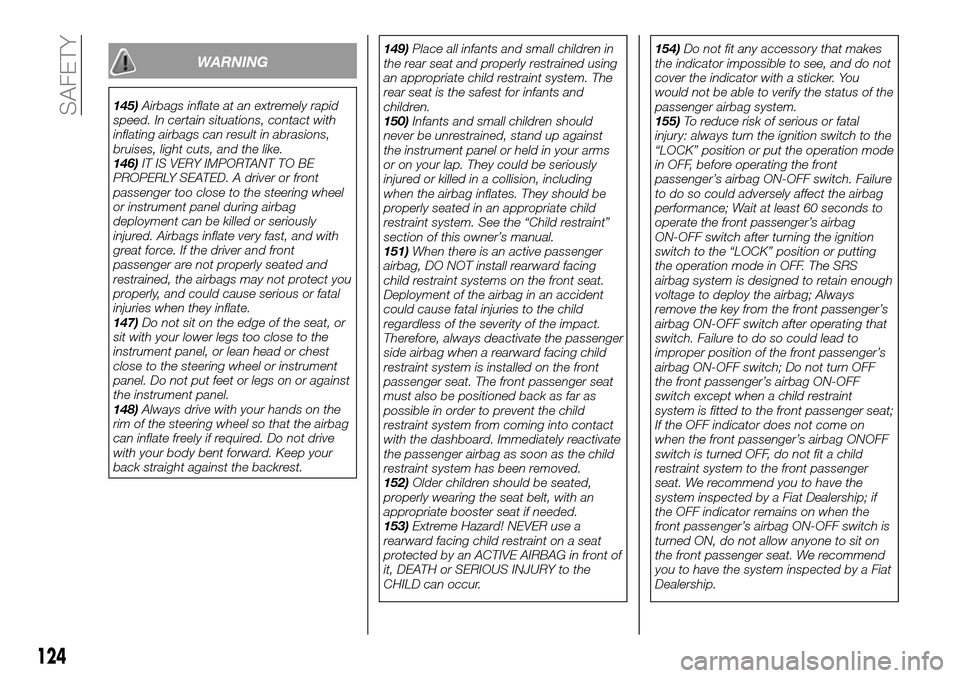
WARNING
145)Airbags inflate at an extremely rapid
speed. In certain situations, contact with
inflating airbags can result in abrasions,
bruises, light cuts, and the like.
146)IT IS VERY IMPORTANT TO BE
PROPERLY SEATED. A driver or front
passenger too close to the steering wheel
or instrument panel during airbag
deployment can be killed or seriously
injured. Airbags inflate very fast, and with
great force. If the driver and front
passenger are not properly seated and
restrained, the airbags may not protect you
properly, and could cause serious or fatal
injuries when they inflate.
147)Do not sit on the edge of the seat, or
sit with your lower legs too close to the
instrument panel, or lean head or chest
close to the steering wheel or instrument
panel. Do not put feet or legs on or against
the instrument panel.
148)Always drive with your hands on the
rim of the steering wheel so that the airbag
can inflate freely if required. Do not drive
with your body bent forward. Keep your
back straight against the backrest.149)Place all infants and small children in
the rear seat and properly restrained using
an appropriate child restraint system. The
rear seat is the safest for infants and
children.
150)Infants and small children should
never be unrestrained, stand up against
the instrument panel or held in your arms
or on your lap. They could be seriously
injured or killed in a collision, including
when the airbag inflates. They should be
properly seated in an appropriate child
restraint system. See the “Child restraint”
section of this owner’s manual.
151)When there is an active passenger
airbag, DO NOT install rearward facing
child restraint systems on the front seat.
Deployment of the airbag in an accident
could cause fatal injuries to the child
regardless of the severity of the impact.
Therefore, always deactivate the passenger
side airbag when a rearward facing child
restraint system is installed on the front
passenger seat. The front passenger seat
must also be positioned back as far as
possible in order to prevent the child
restraint system from coming into contact
with the dashboard. Immediately reactivate
the passenger airbag as soon as the child
restraint system has been removed.
152)Older children should be seated,
properly wearing the seat belt, with an
appropriate booster seat if needed.
153)Extreme Hazard! NEVER use a
rearward facing child restraint on a seat
protected by an ACTIVE AIRBAG in front of
it, DEATH or SERIOUS INJURY to the
CHILD can occur.154)Do not fit any accessory that makes
the indicator impossible to see, and do not
cover the indicator with a sticker. You
would not be able to verify the status of the
passenger airbag system.
155)To reduce risk of serious or fatal
injury: always turn the ignition switch to the
“LOCK” position or put the operation mode
in OFF, before operating the front
passenger’s airbag ON-OFF switch. Failure
to do so could adversely affect the airbag
performance; Wait at least 60 seconds to
operate the front passenger’s airbag
ON-OFF switch after turning the ignition
switch to the “LOCK” position or putting
the operation mode in OFF. The SRS
airbag system is designed to retain enough
voltage to deploy the airbag; Always
remove the key from the front passenger’s
airbag ON-OFF switch after operating that
switch. Failure to do so could lead to
improper position of the front passenger’s
airbag ON-OFF switch; Do not turn OFF
the front passenger’s airbag ON-OFF
switch except when a child restraint
system is fitted to the front passenger seat;
If the OFF indicator does not come on
when the front passenger’s airbag ONOFF
switch is turned OFF, do not fit a child
restraint system to the front passenger
seat. We recommend you to have the
system inspected by a Fiat Dealership; if
the OFF indicator remains on when the
front passenger’s airbag ON-OFF switch is
turned ON, do not allow anyone to sit on
the front passenger seat. We recommend
you to have the system inspected by a Fiat
Dealership.
124
SAFETY
Page 127 of 312
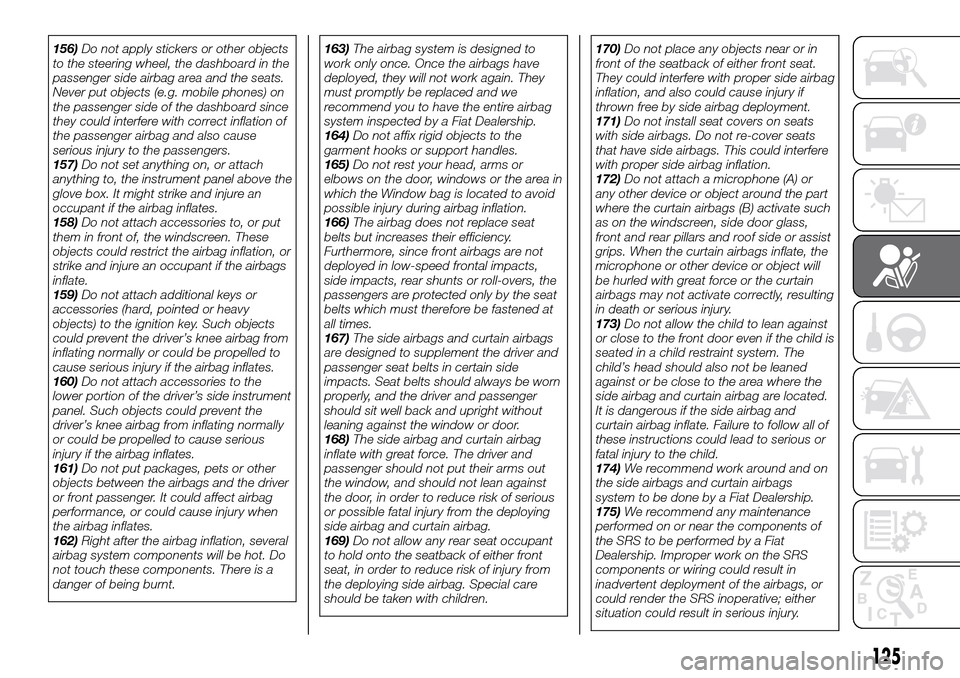
156)Do not apply stickers or other objects
to the steering wheel, the dashboard in the
passenger side airbag area and the seats.
Never put objects (e.g. mobile phones) on
the passenger side of the dashboard since
they could interfere with correct inflation of
the passenger airbag and also cause
serious injury to the passengers.
157)Do not set anything on, or attach
anything to, the instrument panel above the
glove box. It might strike and injure an
occupant if the airbag inflates.
158)Do not attach accessories to, or put
them in front of, the windscreen. These
objects could restrict the airbag inflation, or
strike and injure an occupant if the airbags
inflate.
159)Do not attach additional keys or
accessories (hard, pointed or heavy
objects) to the ignition key. Such objects
could prevent the driver’s knee airbag from
inflating normally or could be propelled to
cause serious injury if the airbag inflates.
160)Do not attach accessories to the
lower portion of the driver’s side instrument
panel. Such objects could prevent the
driver’s knee airbag from inflating normally
or could be propelled to cause serious
injury if the airbag inflates.
161)Do not put packages, pets or other
objects between the airbags and the driver
or front passenger. It could affect airbag
performance, or could cause injury when
the airbag inflates.
162)Right after the airbag inflation, several
airbag system components will be hot. Do
not touch these components. There is a
danger of being burnt.163)The airbag system is designed to
work only once. Once the airbags have
deployed, they will not work again. They
must promptly be replaced and we
recommend you to have the entire airbag
system inspected by a Fiat Dealership.
164)Do not affix rigid objects to the
garment hooks or support handles.
165)Do not rest your head, arms or
elbows on the door, windows or the area in
which the Window bag is located to avoid
possible injury during airbag inflation.
166)The airbag does not replace seat
belts but increases their efficiency.
Furthermore, since front airbags are not
deployed in low-speed frontal impacts,
side impacts, rear shunts or roll-overs, the
passengers are protected only by the seat
belts which must therefore be fastened at
all times.
167)The side airbags and curtain airbags
are designed to supplement the driver and
passenger seat belts in certain side
impacts. Seat belts should always be worn
properly, and the driver and passenger
should sit well back and upright without
leaning against the window or door.
168)The side airbag and curtain airbag
inflate with great force. The driver and
passenger should not put their arms out
the window, and should not lean against
the door, in order to reduce risk of serious
or possible fatal injury from the deploying
side airbag and curtain airbag.
169)Do not allow any rear seat occupant
to hold onto the seatback of either front
seat, in order to reduce risk of injury from
the deploying side airbag. Special care
should be taken with children.170)Do not place any objects near or in
front of the seatback of either front seat.
They could interfere with proper side airbag
inflation, and also could cause injury if
thrown free by side airbag deployment.
171)Do not install seat covers on seats
with side airbags. Do not re-cover seats
that have side airbags. This could interfere
with proper side airbag inflation.
172)Do not attach a microphone (A) or
any other device or object around the part
where the curtain airbags (B) activate such
as on the windscreen, side door glass,
front and rear pillars and roof side or assist
grips. When the curtain airbags inflate, the
microphone or other device or object will
be hurled with great force or the curtain
airbags may not activate correctly, resulting
in death or serious injury.
173)Do not allow the child to lean against
or close to the front door even if the child is
seated in a child restraint system. The
child’s head should also not be leaned
against or be close to the area where the
side airbag and curtain airbag are located.
It is dangerous if the side airbag and
curtain airbag inflate. Failure to follow all of
these instructions could lead to serious or
fatal injury to the child.
174)We recommend work around and on
the side airbags and curtain airbags
system to be done by a Fiat Dealership.
175)We recommend any maintenance
performed on or near the components of
the SRS to be performed by a Fiat
Dealership. Improper work on the SRS
components or wiring could result in
inadvertent deployment of the airbags, or
could render the SRS inoperative; either
situation could result in serious injury.
125
Page 128 of 312
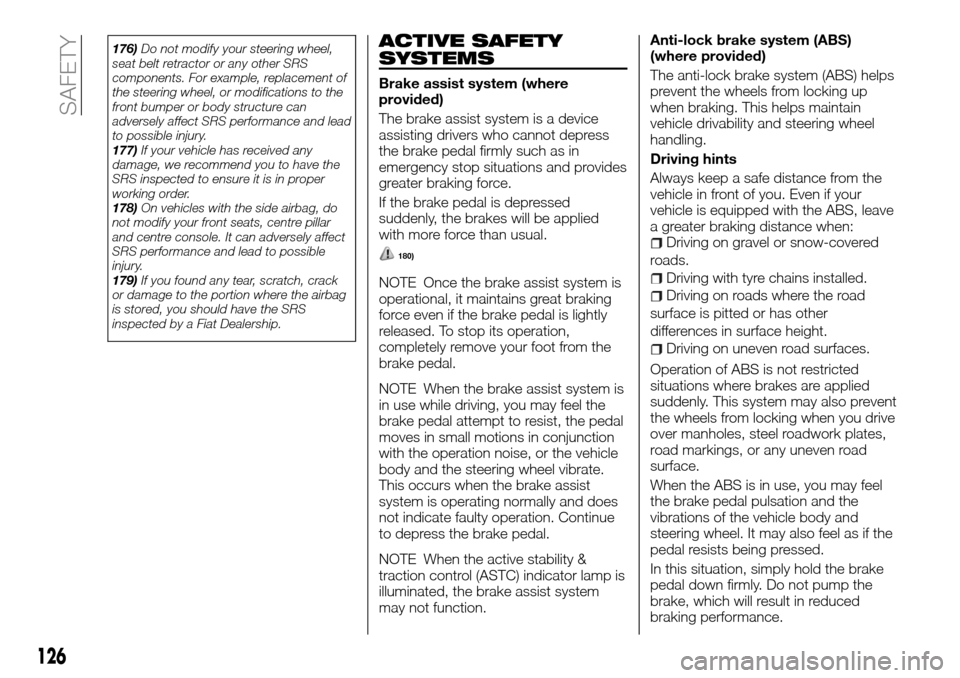
176)Do not modify your steering wheel,
seat belt retractor or any other SRS
components. For example, replacement of
the steering wheel, or modifications to the
front bumper or body structure can
adversely affect SRS performance and lead
to possible injury.
177)If your vehicle has received any
damage, we recommend you to have the
SRS inspected to ensure it is in proper
working order.
178)On vehicles with the side airbag, do
not modify your front seats, centre pillar
and centre console. It can adversely affect
SRS performance and lead to possible
injury.
179)If you found any tear, scratch, crack
or damage to the portion where the airbag
is stored, you should have the SRS
inspected by a Fiat Dealership.ACTIVE SAFETY
SYSTEMS
Brake assist system (where
provided)
The brake assist system is a device
assisting drivers who cannot depress
the brake pedal firmly such as in
emergency stop situations and provides
greater braking force.
If the brake pedal is depressed
suddenly, the brakes will be applied
with more force than usual.
180)
NOTE Once the brake assist system is
operational, it maintains great braking
force even if the brake pedal is lightly
released. To stop its operation,
completely remove your foot from the
brake pedal.
NOTE When the brake assist system is
in use while driving, you may feel the
brake pedal attempt to resist, the pedal
moves in small motions in conjunction
with the operation noise, or the vehicle
body and the steering wheel vibrate.
This occurs when the brake assist
system is operating normally and does
not indicate faulty operation. Continue
to depress the brake pedal.
NOTE When the active stability &
traction control (ASTC) indicator lamp is
illuminated, the brake assist system
may not function.Anti-lock brake system (ABS)
(where provided)
The anti-lock brake system (ABS) helps
prevent the wheels from locking up
when braking. This helps maintain
vehicle drivability and steering wheel
handling.
Driving hints
Always keep a safe distance from the
vehicle in front of you. Even if your
vehicle is equipped with the ABS, leave
a greater braking distance when:
Driving on gravel or snow-covered
roads.
Driving with tyre chains installed.
Driving on roads where the road
surface is pitted or has other
differences in surface height.
Driving on uneven road surfaces.
Operation of ABS is not restricted
situations where brakes are applied
suddenly. This system may also prevent
the wheels from locking when you drive
over manholes, steel roadwork plates,
road markings, or any uneven road
surface.
When the ABS is in use, you may feel
the brake pedal pulsation and the
vibrations of the vehicle body and
steering wheel. It may also feel as if the
pedal resists being pressed.
In this situation, simply hold the brake
pedal down firmly. Do not pump the
brake, which will result in reduced
braking performance.
126
SAFETY
Page 129 of 312
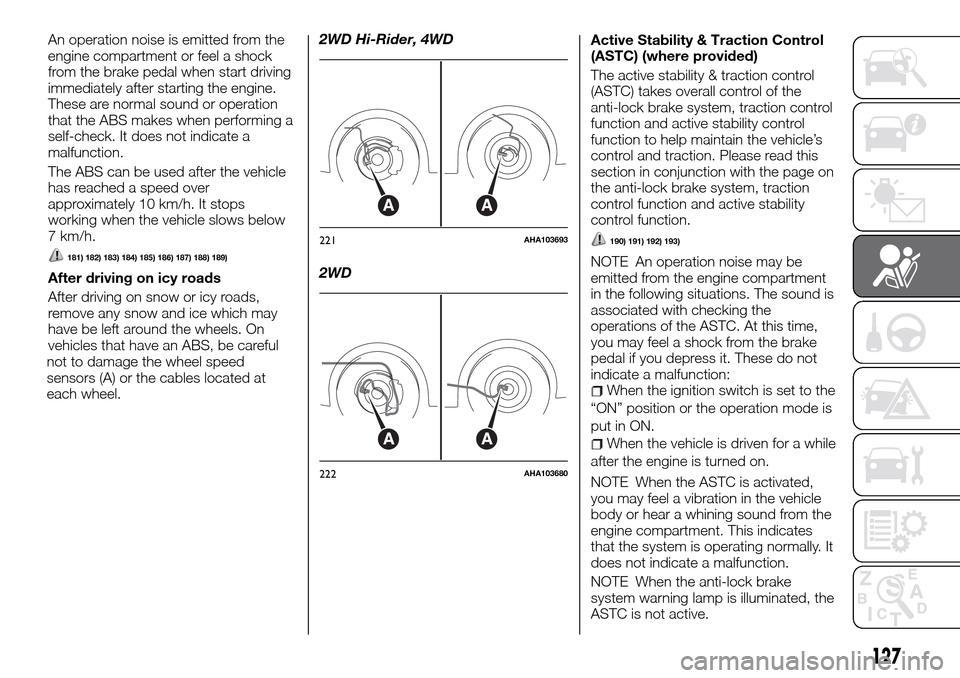
An operation noise is emitted from the
engine compartment or feel a shock
from the brake pedal when start driving
immediately after starting the engine.
These are normal sound or operation
that the ABS makes when performing a
self-check. It does not indicate a
malfunction.
The ABS can be used after the vehicle
has reached a speed over
approximately 10 km/h. It stops
working when the vehicle slows below
7 km/h.
181) 182) 183) 184) 185) 186) 187) 188) 189)
After driving on icy roads
After driving on snow or icy roads,
remove any snow and ice which may
have be left around the wheels. On
vehicles that have an ABS, be careful
not to damage the wheel speed
sensors (A) or the cables located at
each wheel.2WD Hi-Rider, 4WD
2WDActive Stability & Traction Control
(ASTC) (where provided)
The active stability & traction control
(ASTC) takes overall control of the
anti-lock brake system, traction control
function and active stability control
function to help maintain the vehicle’s
control and traction. Please read this
section in conjunction with the page on
the anti-lock brake system, traction
control function and active stability
control function.
190) 191) 192) 193)
NOTE An operation noise may be
emitted from the engine compartment
in the following situations. The sound is
associated with checking the
operations of the ASTC. At this time,
you may feel a shock from the brake
pedal if you depress it. These do not
indicate a malfunction:
When the ignition switch is set to the
“ON” position or the operation mode is
put in ON.
When the vehicle is driven for a while
after the engine is turned on.
NOTE When the ASTC is activated,
you may feel a vibration in the vehicle
body or hear a whining sound from the
engine compartment. This indicates
that the system is operating normally. It
does not indicate a malfunction.
NOTE When the anti-lock brake
system warning lamp is illuminated, the
ASTC is not active.
AA
221AHA103693
AA
222AHA103680
127
Page 130 of 312
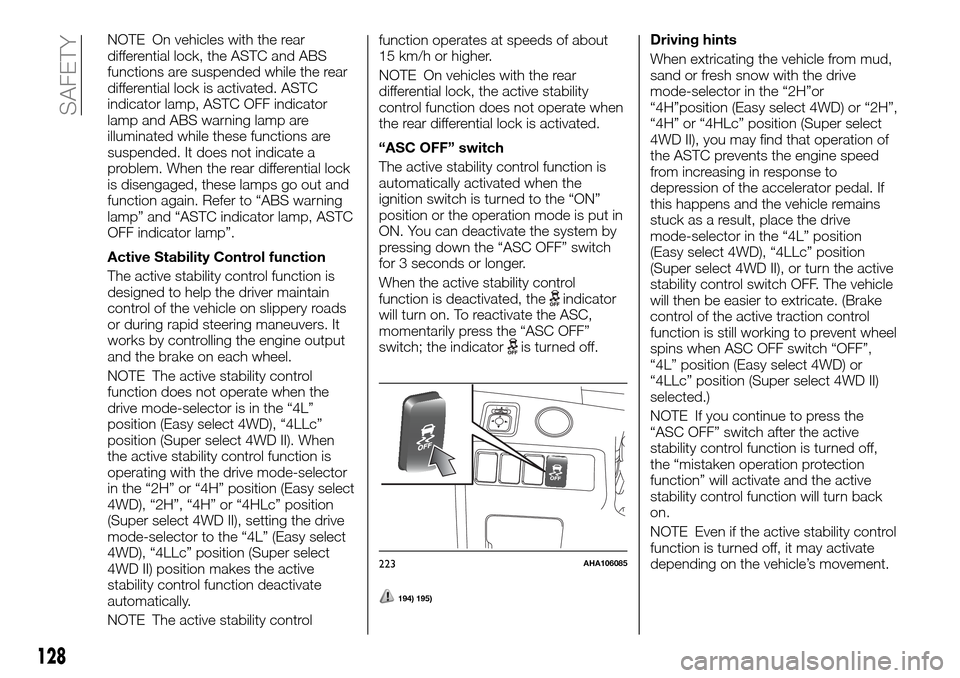
NOTE On vehicles with the rear
differential lock, the ASTC and ABS
functions are suspended while the rear
differential lock is activated. ASTC
indicator lamp, ASTC OFF indicator
lamp and ABS warning lamp are
illuminated while these functions are
suspended. It does not indicate a
problem. When the rear differential lock
is disengaged, these lamps go out and
function again. Refer to “ABS warning
lamp” and “ASTC indicator lamp, ASTC
OFF indicator lamp”.
Active Stability Control function
The active stability control function is
designed to help the driver maintain
control of the vehicle on slippery roads
or during rapid steering maneuvers. It
works by controlling the engine output
and the brake on each wheel.
NOTE The active stability control
function does not operate when the
drive mode-selector is in the “4L”
position (Easy select 4WD), “4LLc”
position (Super select 4WD II). When
the active stability control function is
operating with the drive mode-selector
in the “2H” or “4H” position (Easy select
4WD), “2H”, “4H” or “4HLc” position
(Super select 4WD II), setting the drive
mode-selector to the “4L” (Easy select
4WD), “4LLc” position (Super select
4WD II) position makes the active
stability control function deactivate
automatically.
NOTE The active stability controlfunction operates at speeds of about
15 km/h or higher.
NOTE On vehicles with the rear
differential lock, the active stability
control function does not operate when
the rear differential lock is activated.
“ASC OFF” switch
The active stability control function is
automatically activated when the
ignition switch is turned to the “ON”
position or the operation mode is put in
ON. You can deactivate the system by
pressing down the “ASC OFF” switch
for 3 seconds or longer.
When the active stability control
function is deactivated, the
indicator
will turn on. To reactivate the ASC,
momentarily press the “ASC OFF”
switch; the indicator
is turned off.
194) 195)
Driving hints
When extricating the vehicle from mud,
sand or fresh snow with the drive
mode-selector in the “2H”or
“4H”position (Easy select 4WD) or “2H”,
“4H” or “4HLc” position (Super select
4WD II), you may find that operation of
the ASTC prevents the engine speed
from increasing in response to
depression of the accelerator pedal. If
this happens and the vehicle remains
stuck as a result, place the drive
mode-selector in the “4L” position
(Easy select 4WD), “4LLc” position
(Super select 4WD II), or turn the active
stability control switch OFF. The vehicle
will then be easier to extricate. (Brake
control of the active traction control
function is still working to prevent wheel
spins when ASC OFF switch “OFF”,
“4L” position (Easy select 4WD) or
“4LLc” position (Super select 4WD II)
selected.)
NOTE If you continue to press the
“ASC OFF” switch after the active
stability control function is turned off,
the “mistaken operation protection
function” will activate and the active
stability control function will turn back
on.
NOTE Even if the active stability control
function is turned off, it may activate
depending on the vehicle’s movement.
LR
223AHA106085
128
SAFETY